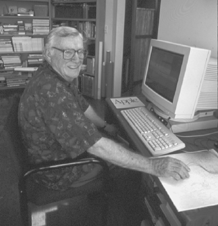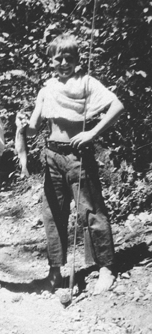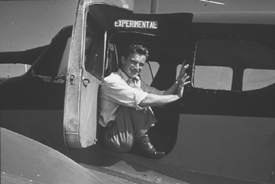

by Wally Graves

TALK ABOUT AN ACT OF FAITH!
We offramped Highway 101 at the Arcata Airport where the fog was so dense we couldn't see the terminal building from the highway.And once in the terminal we could scarcely see the runway.
My wife asked the attendant at the United desk, "Is the flight cancelled?"
"No," he assured her. "This is nothing."
Sure enough, through the soupy mist a few minutes later the plane from San Francisco set down, taxied through the fog to the terminal apron, unloaded its passengers, loaded my wife and the others aboard, and disappeared toward the unseen runway.
A moment later an assuring roar told us that our beloved passengers were bound upward, somewhere in the general direction of heaven.
Stanley "Neb" Roscoe, who lives with his wife Gayle Karshner on Azalea Hill under the final approach of incoming planes, has spent his professional life designing user-friendly cockpits (now called "flightdecks"), and devising tests to assure that the pilots in those flightdecks are the most likely candidates for flying.

Something of Neb's work is aboard every commercial takeoff and landing in major airports around the world. His latest venture is a testing device called WOMBAT® scheduled this December to be aboard the Russian space station MIR.
Neb was born in Eureka Nov. 4, 1920, to a sheep-ranch family living in the Mattole Valley -- a time when, during the three previous years, pilots in their open cockpit single-engine biplanes had died by the dozens trying to establish transcontinental air mail. They flew by compass, road map, and "the seat of their pants" from San Francisco to New York in stages, like the Pony Express 60 years before.

Neb was 3 months old when, on Washington's Birthday, 1921, a plane took off from San Francisco at 5:30 a.m. Pacific Time, flew that night over the Great Plains guided by bonfires and landed on New York's Long Island at 4:50 p.m. Eastern Time the next day, a trip of 33 hours and 20 minutes, halving the earlier transcontinental record of 72 hours.
The plane carried 350 pounds of mail. It was one of four De Haviland 4s which tried it that day. One crashed, killing the pilot, near Winnemucca, Nev. The other two, from New York, were grounded by mist in Pennsylvania and a storm in Chicago.
During the '20s the guiding bonfires were replaced with powerful electric searchlights, and later with radio beacons. At the decade's end Elmer Sperry and his two sons developed a gyroscope with an artificial horizon by which an Army daredevil named Jimmy Doolittle flew blind for the first time to prove night flying possible.
(Like a spinning top, a gyro compass in a gimbals stays upright even when the gimbals tilts, thereby installing in the aircraft a constant point by which the airplane's direction of flight, and attitude, can be instantly read.)
Doolittle flew concealed in his cockpit for 15 minutes that day over Long Island. He landed within yards of where the plane took off. The date was Sept. 24, 1929. Neb was nearly 9 years old.
With night and low-visibility flying a reality, airlines developed transcontinental routes during the '30s. By the '40s and World War II, the plane of choice was Donald Douglas's DC-3, the world's commercial workhorse. Neb was completing a bachelor's degree from Humboldt State College in speech and English, and working on a survey crew for the U.S. Army Corps of Engineers at the Arcata airport when he enlisted in the Army Air Corps.
As a pilot in World War II he learned the shortcomings of both plane and pilot training, so after the war he enrolled in a graduate program in engineering psychology at the University of Illinois where he pioneered research which today allows pilots, in their pressurized aircraft guided by radio signals, to watch a screen that pictures for them their position in flight. An on-board computer follows their instructions.
Today's flight wouldn't be possible were it not for researchers like Neb who studied not only the reactions of pilots to the real world seen by the naked eye and heard by the ear and felt by the body, but also to a world projected onto a screen.
If you will, Neb was a pioneer in pursuit of Virtual Reality in the infancy of television and before personal computers. Working with primitive electromechanical equipment he and his fellow researchers pioneered what today are map displays on aircraft and in air traffic control centers which tell at a glance the craft's position, direction and speed. In 1948 Neb's group placed the first map display in a pilot training simulator. In 1951 they developed the first traffic control simulator.
A third contribution in the 1950s was the now-familiar landing display giving pilots an out-of-cockpit "look" at what otherwise might be a blind approach. This landing display dramatically increased trainees' skills, and reduced their training time in airplanes. Today's mammoth Boeing 747 (and the new 777) commercial flights find at the controls transition pilots who've never flown this particular model before. Their simulator training alone has prepared them for the real thing.

Neb's master's degree in Experimental Engineering Psychology came in 1947, his doctorate in 1950.
After five years at Illinois he joined Hughes Aircraft in Culver City. He established the industry's first program of experimental research on human factors in aircraft system design. He pioneered the use of military ground-based and airborne flight simulators, installed the first airborne simulator, and was primarily responsible for the advent of optically projected map-type flightdeck displays for area navigation using sophisticated radio guidance systems.
Seventeen years later he left Hughes as manager of the Display Systems Department. He returned to Illinois as associate director for research at the Institute of Aviation, and was involved in some 60 graduate theses in behavioral engineering, and in the new computer science.
Back at Hughes, on leave from Illinois, he renewed his investigation of visual perception with visual displays at NASA's Ames Research Center in Mountain View where he discovered "the high correlation between the distance of the eye's focus and the apparent size of outside objects, which in turn affects apparent height above the runway, and apparent touchdown point."
Neb's findings solved the mystery of why flight simulators require a 25 percent adjustment in magnification to replicate the pilot's sense of the real thing.
For Neb, "pilot error" is not a conclusion. It's a beginning of a search to detect why the pilot erred.
He remembers during World War II when pilots in some planes -- notably the Lockheed P-47, the Boeing B-17, North American's B-25 and the Curtiss C-46 erred in retracting landing gear upon touching down -- a mistake not encountered in the Douglas C-47s (known commercially as the DC-3).
A young psychologist named Alphonse Chapanis observed that identical side-by-side wheel and wingflap toggle switches could easily be confused, and that "the so-called pilot errors were really cockpit design errors." A wartime fix of attaching a rubber-tired wheel to the wheel control, and a small wedge-shaped end to the aileron flap control, ended the "errors."
In today's planes these mnemonically shaped wheel and flap controls are standardized worldwide, as are tactually discriminable heads of other power control levers. But Neb notes that tests show more such coding of knobs and toggle switches would further reduce the chance of "error."
In another aspect of cockpit display, Neb is especially piqued by the Sperry gyroscope which, to this day, shows the plane's attitude by way of a tilted horizon rather than a tilted aircraft (see illustration).
"Jimmy Doolittle," Neb recounts, "and other pilots experienced difficulty in remembering that the moving bar represented the horizon and not the airplane." Neb has written, "It was realized that there was a problem. A few radical thinkers advanced the notion that the horizon should be fixed and the airplane symbol should move, just as the pilot perceives his or her own airplane moving against the horizon."
Neb has long theorized that black box data from an Air India crash in the Indian Ocean on Jan. 1, 1978, was caused by pilot confusion over the horizon bar. He further hypothesizes that the recent unsolved US Air Boeing-737 crash near Pittsburgh, which was the focus of a long article in New Yorker magazine in August prompting a rudder-retrofit alert, could well have been caused by the pilot's misreading of the horizon indicator, leading to the plane's "graveyard spiral" instead of a righting of attitude.
If there's a way to prevent these crashes, why hasn't the original configuration been changed? Neb lays it to "defense of manhood." Pilots shun coddling, saying in effect, "Piece of cake. I can do it the way it is. Anybody who can't shouldn't be flying."
Retirement from university work has given Neb time to market, with two partners -- an Australian and a Canadian -- a test they've invented called WOMBAT. WOMBAT has gotten the attention of air agencies in France, Bulgaria, Sweden, Australia, Canada, New Zealand, Saudi Arabia, Jordan -- and in the United States.
And the Russian space station MIR.
In brief, the WOMBAT attempts to predict how well a future pilot will react to crises in actual flight, and how well he or she will interact with the rest of the crew. Research indicates that among four skills -- working memory, visual search, spatial imagery and pattern recognition, the last is most significant.
WOMBAT originally stood for "Wondrous Original Method for Basic Airmanship Testing," but since Neb has discovered that the test may predict equally well the performance of athletes, train engineers and others in high stress mental/physical situations, he's changed "Airmanship" to "Awareness."
(Wombat also means, to the Australian Aborigines, a burrowing marsupial resembling a ground hog.)
In WOMBAT Neb believes he has discovered a measuring stick for something beyond the senses of good eyesight and hearing, and beyond motor controls and acculturated skills. WOMBAT, in an efficient 90 minutes, can predict a person's potential "situational awareness" so crucial in flightdeck emergencies.
Neb says research has determined that the standard tests for potential pilots predict, at best, "only how well trainees will do early into training, with no predictive validity concerning future performance in emergencies." WOMBAT is saving millions of dollars and a lot of time by weeding out unsuitable candidates before they fly or put in time at $1,000-an-hour simulators.
Neb believes that many more lives could be saved by having on your plane a pilot whose potential skill in emergency has been well predicted. WOMBAT on the space station MIR will test the effects of prolonged weightlessness and confinement on the astronauts' "situational awareness."
Like so many high tech products, WOMBAT looks unprepossessing -- a computer disk, a keyboard, and two joy sticks. A book of instructions guides participants, and the results appear on a scale from zero on up.
The lowest score recorded, Neb says, is 25, ranging up to 300. Two hundred and above should generally be what successful pilot candidates would expect to score. The results can be printed out immediately after the test, and no proctor or analyst need be there.
I asked Neb what there was in the Mattole Valley of the 1920s that would give him such credentials.
Neb's forebears came across the plains about the time of the Civil War and settled before the end of the century in the hills back of Petrolia, where they built a dam, and a saw and grist mill. Their first car was a Model-T Ford, famous for making its owner a skilled mechanic. Neb tells stories of his uncles under the engine dropping the motor pan and patching worn bearings with leather, or bacon rind, or keeping carbide gas headlights (which depended on a water reservoir to activate the gas) alight by squirting water -- from whatever masculine source -- into the carbide's reservoir mounted in the running board. (In the '20s everyone was his own Mr. Fixit.)
The Great Depression of the '30s educated Neb's sheep ranching relatives into another sort of resourcefulness. When the price of mutton fell to 3 cents a pound, and wool to 7 cents a pound, Neb's grandmother cleared their bedrooms, sending the family to sleep in tents while she fed and bedded summer holiday fishermen and their families from San Francisco for $1 a day.
And one summer Neb found himself an astounding entrepreneur selling caddis fly larvae -- a great trout bait -- for $1 a can. (He could fill a can in five minutes from under the rocks among the riffles where the larvae lay.)
At Illinois Neb felt right at home in the makeshift lab. His first of some 250 publications was titled "The effects of eliminating binocular and peripheral monocular visual cues upon airplane pilot performance in landing," published in the Journal of Applied Psychology -- not best seller stuff, but the sort of research upon which we passengers unknowingly base our faith in flying today.
Neb retired from Illinois in 1979, and from a professorship in psychology at New Mexico State in 1986. Life's vicissitudes brought him home to Humboldt County, a widower, where you might hear him now playing jazz on his saxophone at Azalea Hill, pursuing a passion dating back to the '20s when the Ferndale-to-Mattole stage driver, Bill Reynolds, would bring the latest jazz records for the Roscoes' windup phonograph.
In 1989 Neb married Gayle Karshner, herself the widow of Don Karshner, Neb's major advisor for his bachelor's degree at HSU in the early '40s.
My wife and I owe a special debt to Neb's fame beyond the debt owed by all who board a commercial flight these days: In the summer of 1991 we landed in Berlin about the time the famous Wall came tumbling down. At the airport terminal Hotel Service desk we were told there was no place to stay in the city, all rooms booked. However, there was an awkward arrangement of four beds in a small pensione -- two adjoining bedrooms where you had to walk through one to get to the other.
Alongside us at the hotel desk, also looking for a room, another traveler stood with his 16-year-old son.
Might we share these rooms? the hotel lady suggested. "Just for a night or two?"
My wife and I eyed the pale stranger and his slightly overweight offspring. The man was probably a snorer. And on trips to the bathroom would he traipse through our bedroom, or we through his? What a way to rest up after flying from San Francisco via New York and Frankfurt!
We sighed.
We agreed with misgiving.
The man then introduced himself as Ingomar Carlson, a civil servant from Sweden. He asked where we hailed from.
"You've never heard of it," my wife said. "Eureka, a little town in Northern California."
"Oh," Carlson said, "That's where Neb Roscoe comes from. You don't happen to know him, do you?"
We did.
In the back of Carlson's comfortable Saab sedan we laughed all the way to central Berlin.
Read more about Gayle Karshner
Wally Graves, who lives in King Salmon, writes from time to time for the Journal.